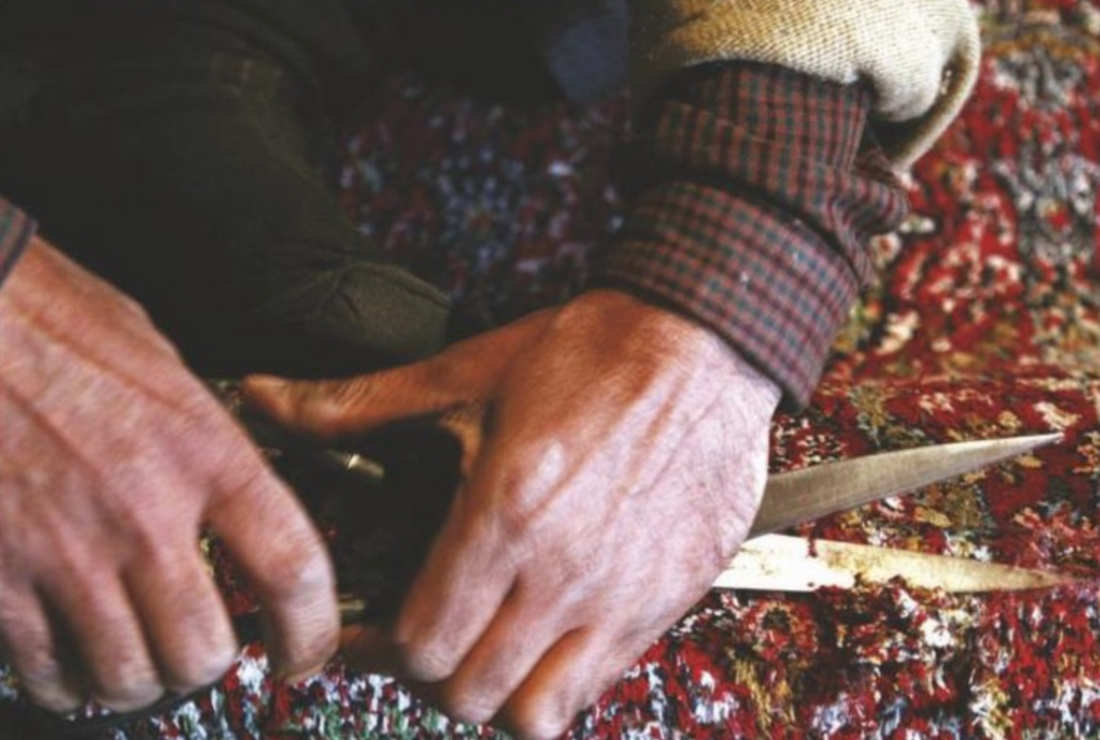
Magic Carpets: Khursheed Dinshaw visits a carpet-weaving home in Kashmir
A man named Abdul, dressed in a grey and black phiran, a garment traditional to Jammu and Kashmir, is sitting cross-legged in front of a loom in his home. With nimble fingers he hand-knots a carpet before offering up Kahwa, a typical local tea. Abdul is one of many weavers in Srinagar who carries forward the carpet weaving legacy handed down by his forefathers. A craft originally brought to Jammu and Kashmir by Persians who also taught Kashmiris the craft of papier mâché, these carpets are always hand-knotted.‘In Kashmir there are more than 600 families who hand-knot these carpets,’ explains Aftab, a fourth generation weaver and carpet seller. ‘They are woven in homes, side by side with other daily responsibilities, like farming.’
The design and colour combination of each carpet is decided by a script held in place by the warp threads.This is a long, coded piece of paper, containing a different code for each colour of the carpet. Even if weavers are not already aware of the design, they simply follow the code and the carpet emerges on the loom. Every family will have two to three designs passed down to them through the generations, and the head of the family always writes the script. Many believe that the reason why it is so hard to find two similar Kashmiri carpets is because once one is woven, its corresponding script is destroyed.

Traditionally red, blue and green are used. Red is symbolic of joy, blue represents seclusion while green is the religious colour of Muslims. Now more than 38 colours are used in the scripts. The first code indicates the colour, so the weaver brings that coloured thread down to make the first loop around one thread from the front and one from the back of the warp. Once the thread is in place, it is brought down and cut using a curved knife, kept in hand during making.Typically, a big carpet is hand-knotted by two people, taking almost seven months to finish. Once a row of loops is done an iron comb is used to compact them tightly together. After each row, a warp thread is used to secure the pile and the weaver pulls a gear which changes the shed.
Want to read more of this article?
We are proud to be a subscriber-funded publication with members in 185 countries. We know our readership is passionate about textiles, so we invite you to help us preserve and promote the stories, memories, and histories that fabric holds. Your support allows us to publish our magazine, and also ‘what's on’ information, and subscription interviews, reviews, and long-read articles in our online blog.
ALREADY A SUBSCRIBER? CLICK HERE TO ACCESS CONTENT
OR...to continue reading….

*Magazine subscribers automatically get free access to all our online content. We send the access code by email with the publication of each issue. You will also find it on the envelope containing your magazine. Please note the access code changes every issue.*
The design and colour combination of each carpet is decided by a script held in place by the warp threads.This is a long, coded piece of paper, containing a different code for each colour of the carpet. Even if weavers are not already aware of the design, they simply follow the code and the carpet emerges on the loom. Every family will have two to three designs passed down to them through the generations, and the head of the family always writes the script. Many believe that the reason why it is so hard to find two similar Kashmiri carpets is because once one is woven, its corresponding script is destroyed.

Traditionally red, blue and green are used. Red is symbolic of joy, blue represents seclusion while green is the religious colour of Muslims. Now more than 38 colours are used in the scripts. The first code indicates the colour, so the weaver brings that coloured thread down to make the first loop around one thread from the front and one from the back of the warp. Once the thread is in place, it is brought down and cut using a curved knife, kept in hand during making.Typically, a big carpet is hand-knotted by two people, taking almost seven months to finish. Once a row of loops is done an iron comb is used to compact them tightly together. After each row, a warp thread is used to secure the pile and the weaver pulls a gear which changes the shed.
Want to read more of this article?
We are proud to be a subscriber-funded publication with members in 185 countries. We know our readership is passionate about textiles, so we invite you to help us preserve and promote the stories, memories, and histories that fabric holds. Your support allows us to publish our magazine, and also ‘what's on’ information, and subscription interviews, reviews, and long-read articles in our online blog.
ALREADY A SUBSCRIBER? CLICK HERE TO ACCESS CONTENT
OR...to continue reading….

*Magazine subscribers automatically get free access to all our online content. We send the access code by email with the publication of each issue. You will also find it on the envelope containing your magazine. Please note the access code changes every issue.*
